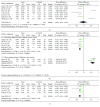Circulating Nesfatin-1 Levels and Type 2 Diabetes: A Systematic Review and Meta-Analysis
- PMID: 29445751
- PMCID: PMC5763168
- DOI: 10.1155/2017/7687098
Circulating Nesfatin-1 Levels and Type 2 Diabetes: A Systematic Review and Meta-Analysis
Abstract
The role of nesfatin-1 in glucose homeostasis has been investigated previously. However, although numerous studies have examined the relationships between circulating nesfatin-1 levels and type 2 diabetes, the conclusions are contradictory. We aimed to probe the relationship between circulating nesfatin-1 levels and type 2 diabetes by meta-analysis. Seven studies including 328 type 2 diabetes patients and 294 control subjects were included. Although there was no obvious difference in circulating nesfatin-1 levels between patients with type 2 diabetes and the control group (MD = -0.04; 95% CI = -0.32 to -0.23), subgroup analysis showed higher nesfatin-1 levels in newly diagnosed type 2 diabetes patients (MD = 0.59; 95% CI = 0.45 to 0.74) and significantly lower nesfatin-1 levels in type 2 diabetes patients receiving antidiabetic treatment (MD = -0.26; 95% CI = -0.33 to -0.20). In conclusion, the analysis supports a relationship between circulating nesfatin-1 levels and type 2 diabetes, where newly diagnosed type 2 diabetes was associated with an elevated Nesfatin-1 level, and type 2 diabetes patients receiving antidiabetic treatment showed lower circulating nesfatin-1 levels.
Figures


References
Publication types
MeSH terms
Substances
LinkOut - more resources
Full Text Sources
Other Literature Sources
Medical

